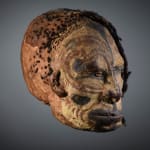An important overmodeled head collected in the village of Kaningra/ Kaningira before 1914, Iatmul People, Middle Sepik, Papua-New-Guinea.
Further images
An impressive Iatmul male skull, sculpted with strikingly masculine features—prominent cheekbones and brow ridges, a pronounced nose, and a square jawline. The face is overpainted with an intricate, high-quality design of lines, whorls, and leaf motifs, emblematic of the clan’s artistic tradition. The skull, meticulously modeled in clay to resemble a lifelike portrait, is adorned with ears and coated in a terracotta-toned surface. The face is covered in fine umber-red and black scrolling patterns, framing cowrie shell eyes set within darkened, mask-like sockets beneath a broad forehead. The hairline is edged with cowrie shells, above remnants of tightly braided black human hair dreadlocks still clinging to the cranium.
Overmodeled skulls were central to the ritual and social life of the Iatmul people of the Sepik River. Created from the exhumed remains of esteemed ancestors, these objects embody the enduring presence of the dead within the living community. After a period of burial, skulls were retrieved and carefully reworked: facial features were modeled in clay, painted with clan symbols, and adorned with shells, feathers, and other organic materials.
Far more than funerary relics, these sculptures served as spiritual portraits, linking the clan to its past and invoking ancestral protection during rites related to mourning, warfare, and prosperity. Typically housed in men's ceremonial structures, they played an active role in community rituals and ancestral veneration.
This finely executed example portrays a young man, possibly a warrior, whose face is rendered with lifelike detail. The original rattan and wood armature remains intact, once festooned with decorative elements. The work exemplifies both the spiritual significance and artistic mastery of the Iatmul tradition, standing as a powerful testament to the cycle of life, death, and memory.
Provenance
-Collected in German New Guinea before 1914
-Acquired by Julius Konietzko from a German Museum collection after 1912
-Acquired by Carl-Otto Czeschka between 1915-1920; it stayed in the family until 1993
-Acquired by Dieter Blume in 1993; it stayed in the family until 2023
Join our mailing list
* denotes required fields
We will process the personal data you have supplied in accordance with our privacy policy (available on request). You can unsubscribe or change your preferences at any time by clicking the link in our emails.













